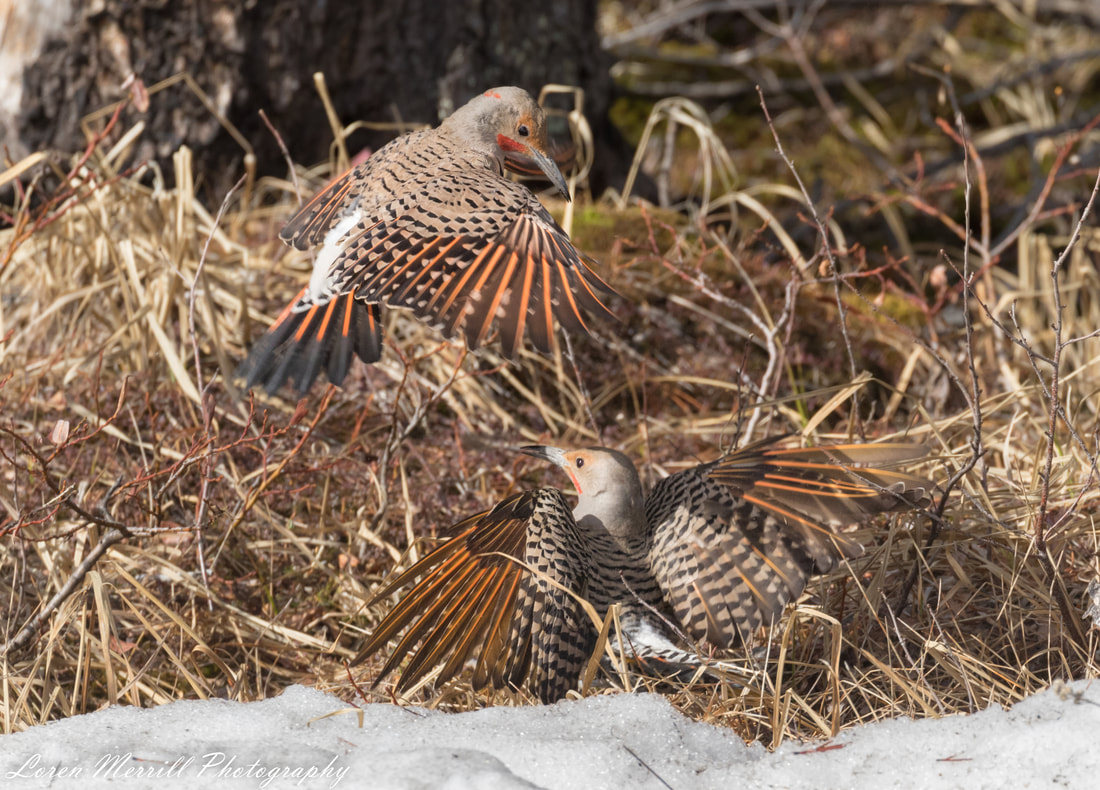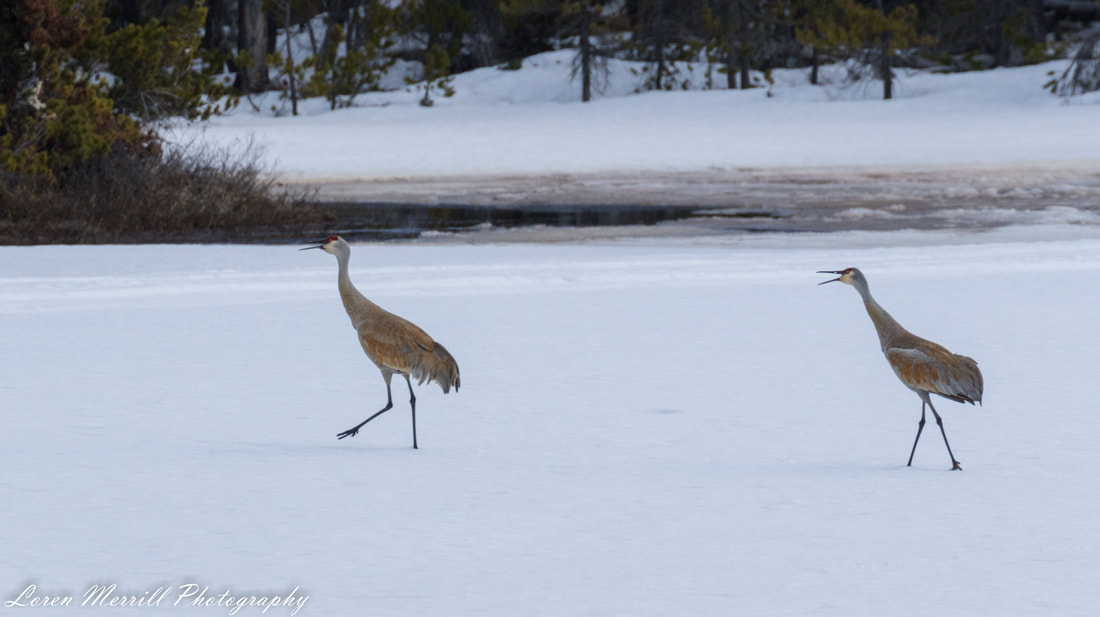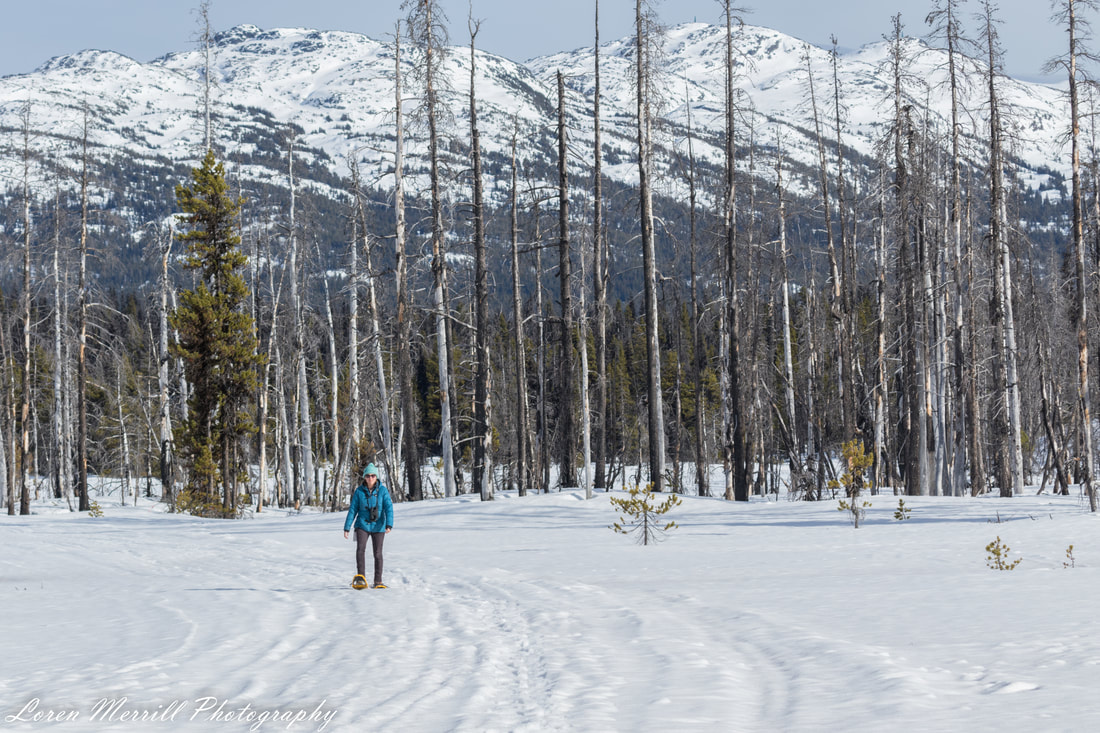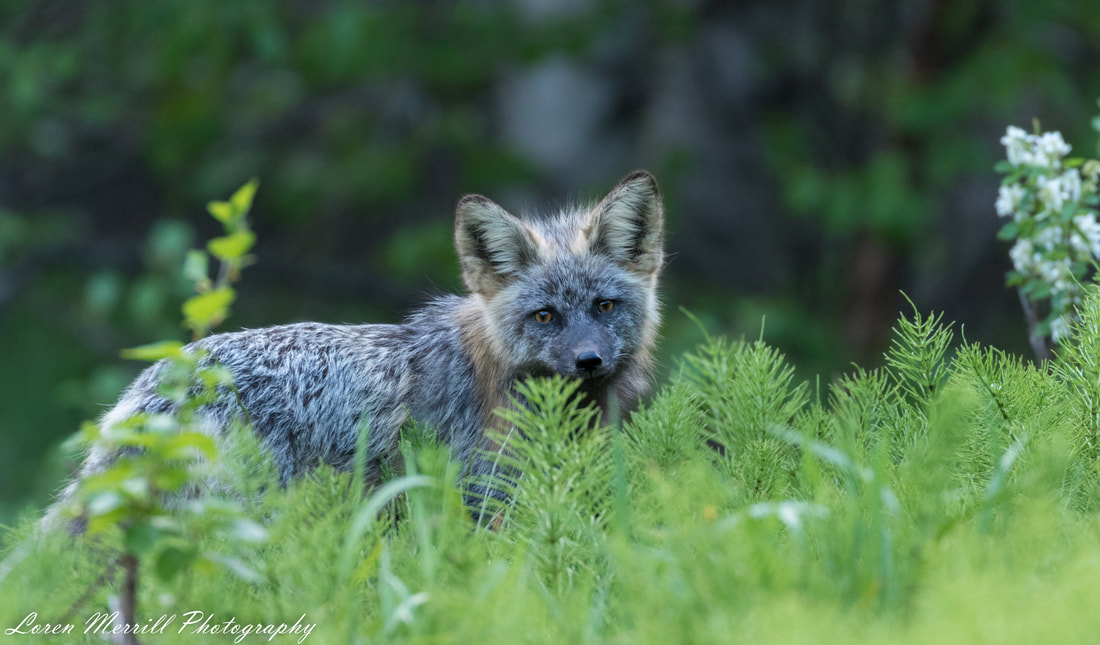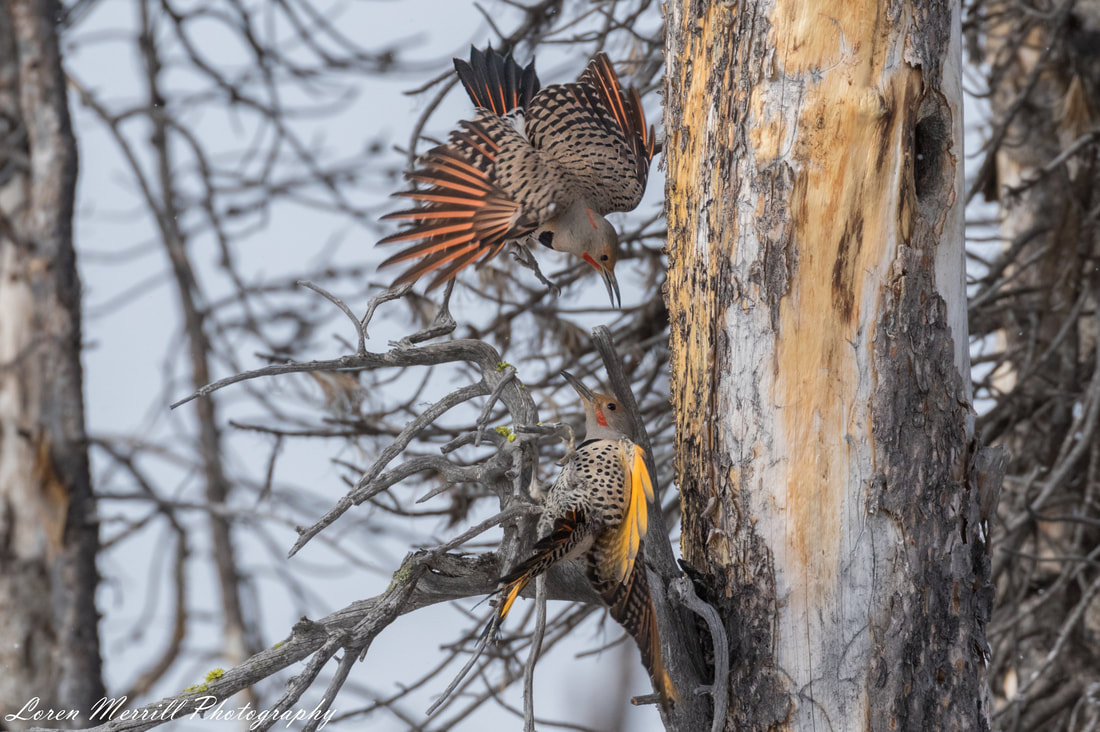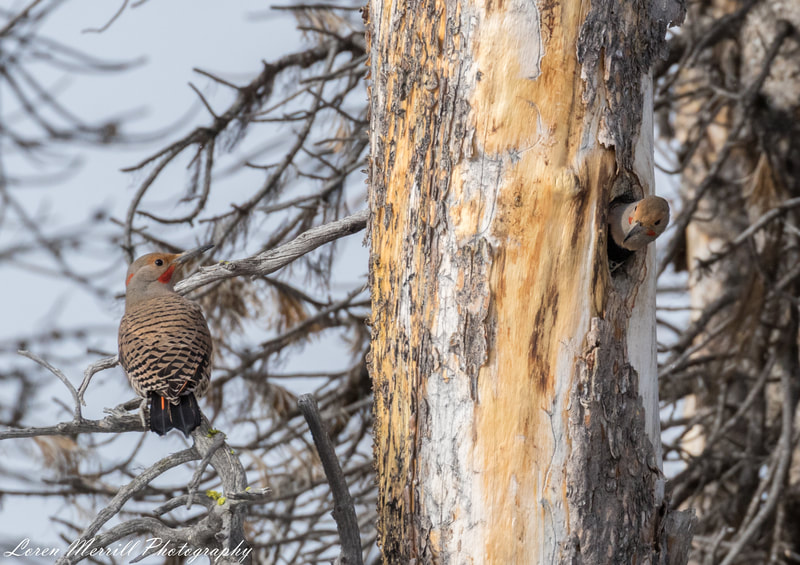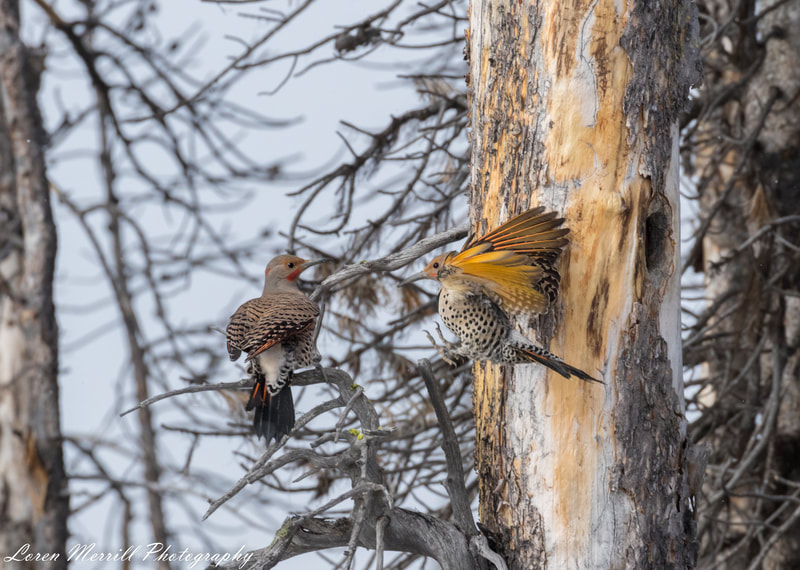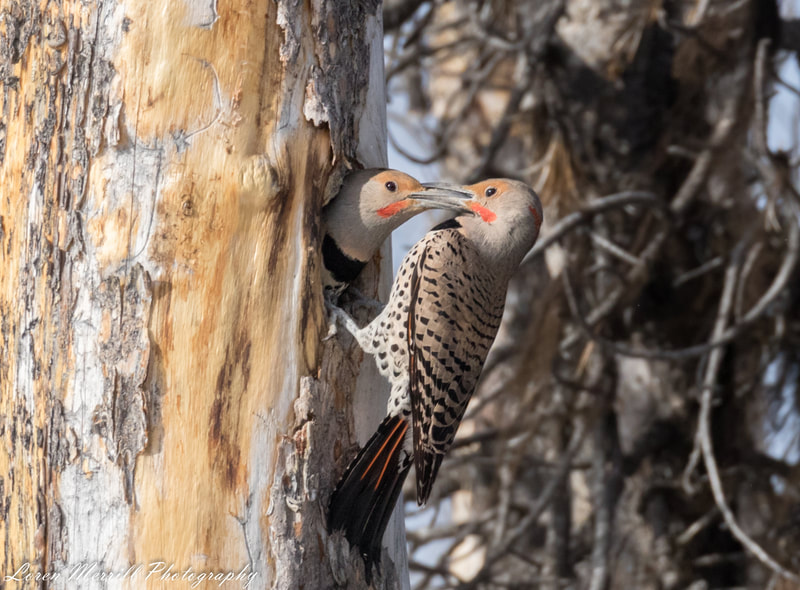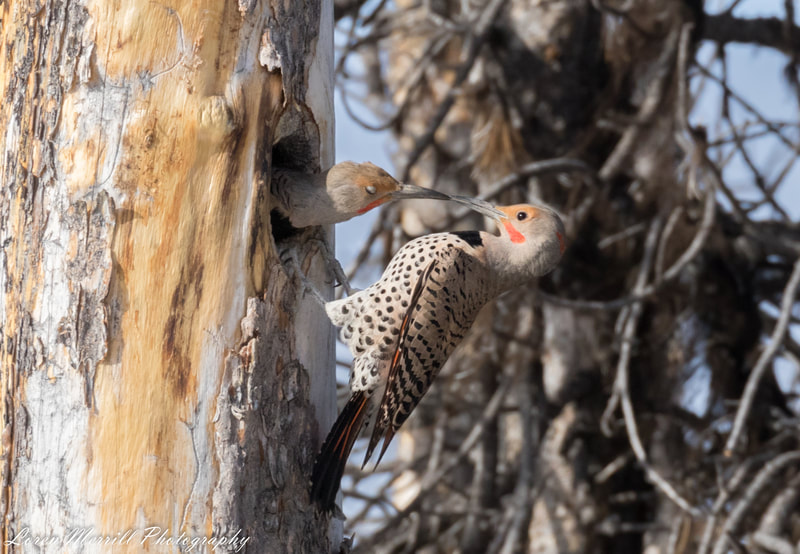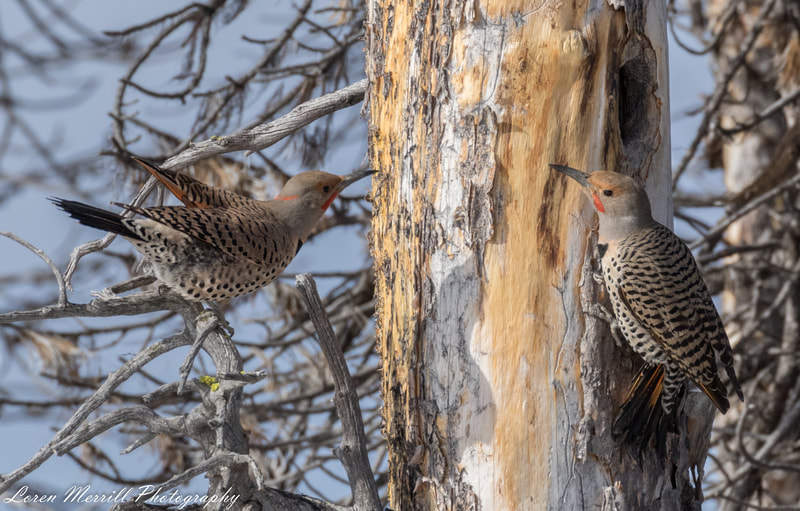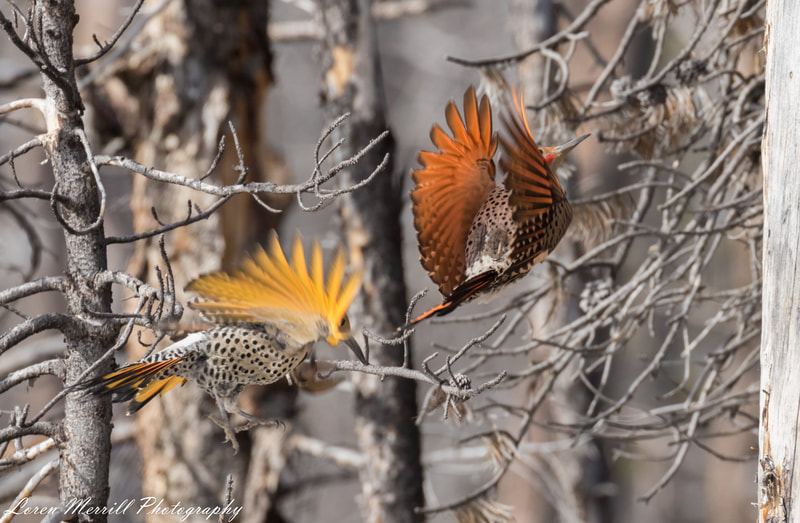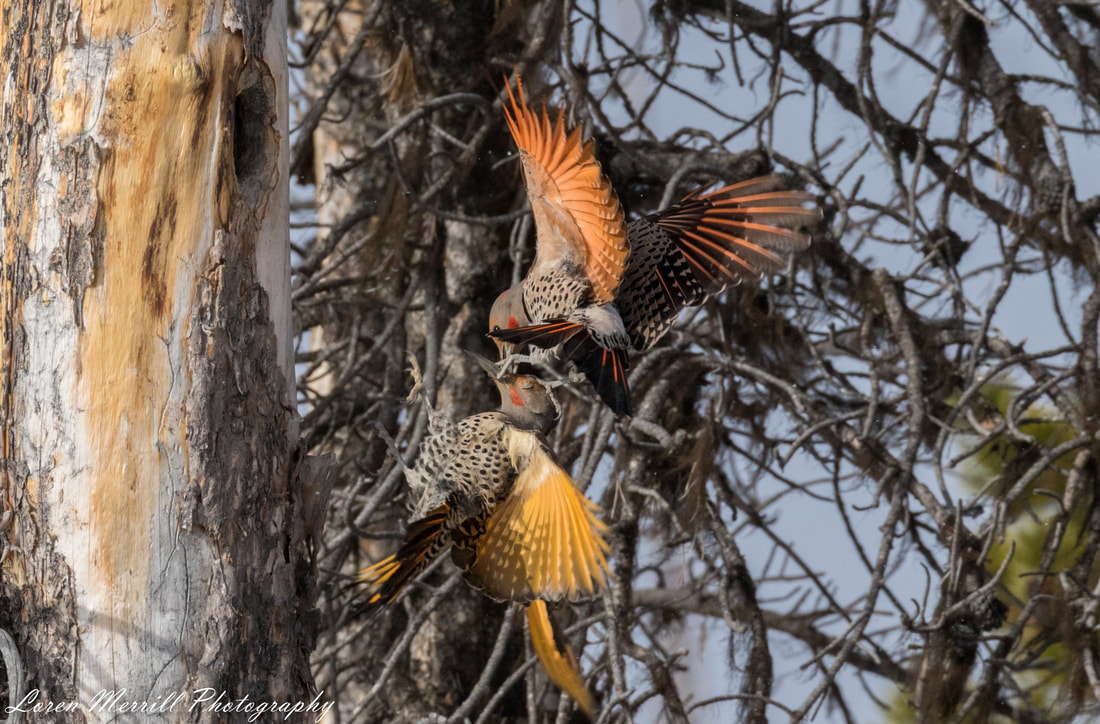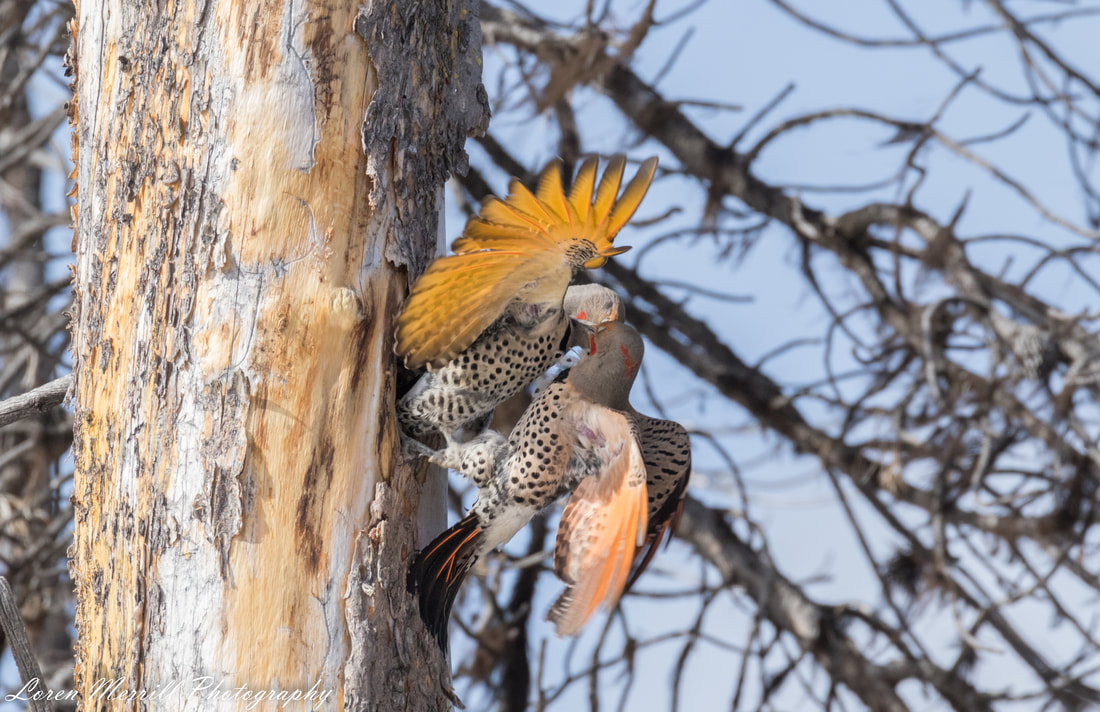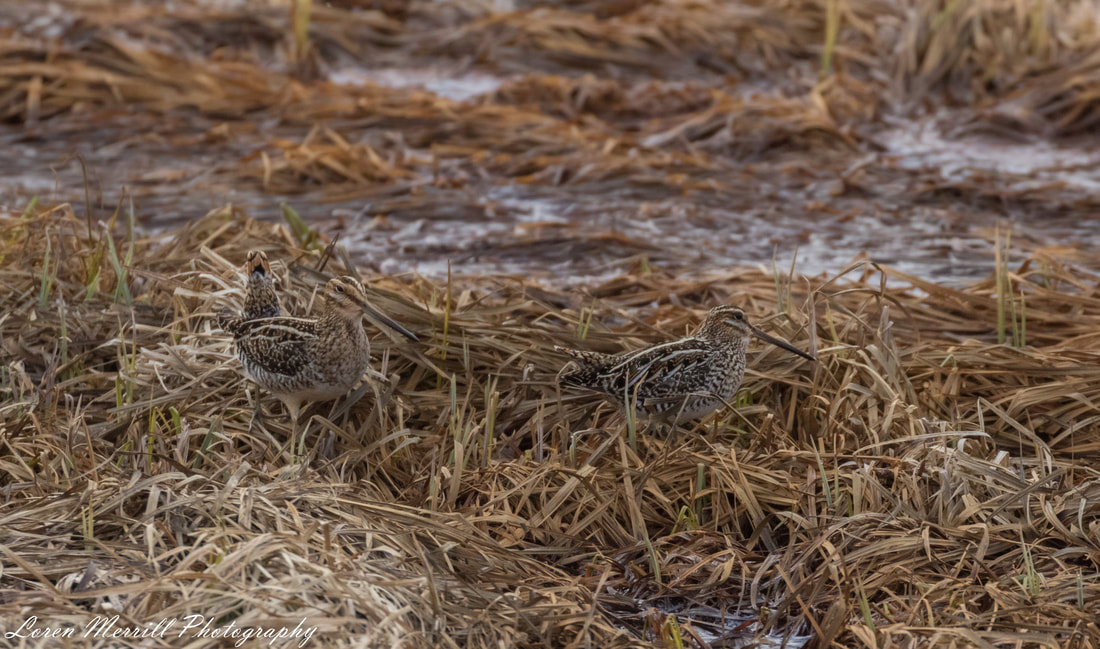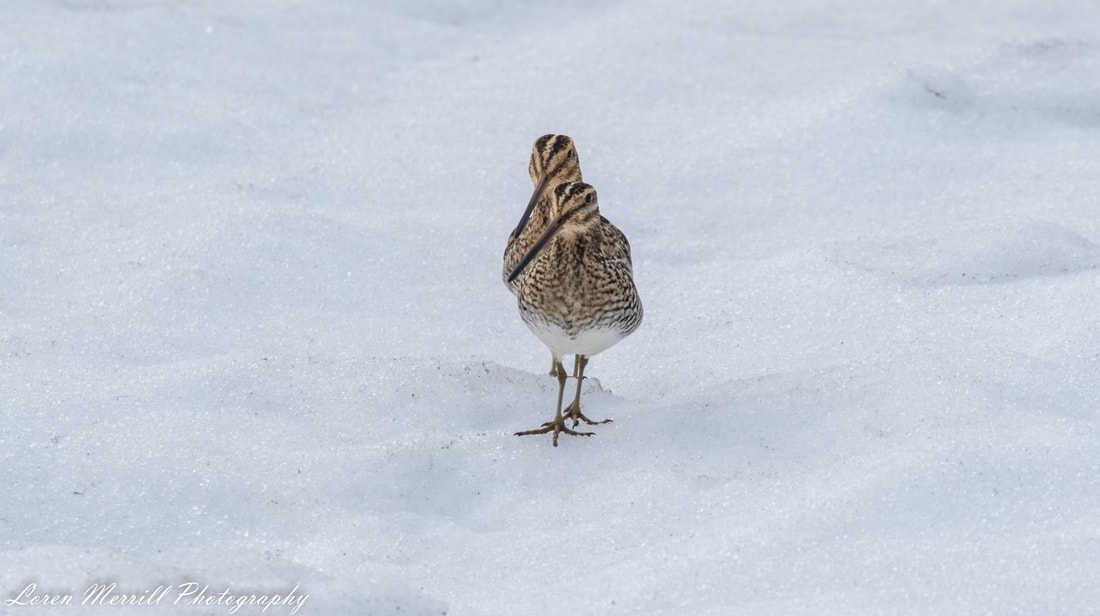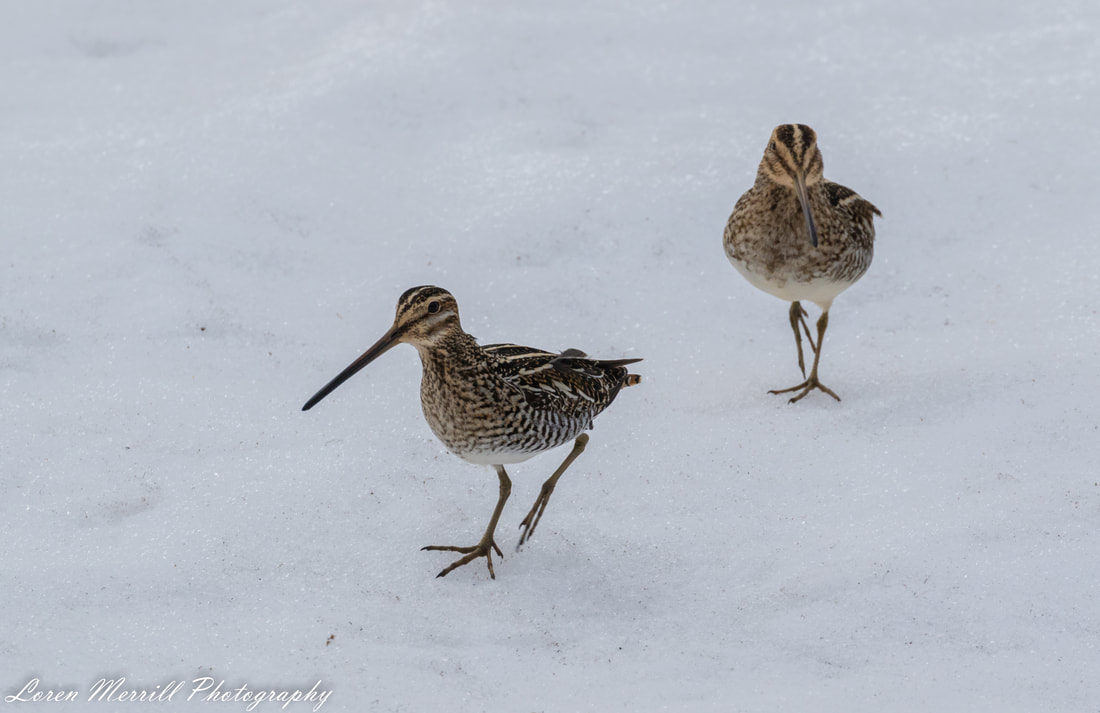|
In late April, I took multiple trips to the Chilcotin Plateau for birdwatching and snowshoeing. This post covers the view from the cabin there, where I saw Sandhill Cranes, displaying Wilson’s Snipes, and an intense fight between two Northern Flickers. The small cabin looked out onto a beautiful wet meadow, edged with forest, and set against a mountain backdrop. Even in late April, most of the meadow was still under a foot or two of snow, although some patches of brown grass were beginning to emerge. As lunch was warming up, I happened to glance out the cabin window just as two large shapes swept past. A pair of sandhill cranes were coming in to land. Upon landing, the cranes erupted into a chorus of bugling calls, celebrating their arrival, or perhaps complaining about cold toes. The two birds picked at patches of bare ground, and then slowly meandered across a snowy section, before disappearing around a finger of forest extending into the meadow. Occasionally they would emerge from behind the trees, and at one point they began displaying. Crane displays are a wonderfully awkward, yet elegant dance in which the lanky birds jump up and down, using their wings to get a bit of extra height. Displaying cranes usually vocalize during the dance, and will even add in a bit of twirling and stick tossing if they’re feeling extra frisky. These birds were just testing out their moves, and soon stalked their way back behind the trees. When the crane show was over, my friends and I (Katie, Dennis and a Belgian traveler, Joren) finished our lunch, packed up our stuff, and left. I was captivated by the place, and formulated a plan to return within a few days with Tara, so that we could spend a night and see what wildlife would emerge during the magic hours of the evening and early morning. The following days were warm and sunny in the valley, and when Tara and I returned to the plateau, there had been a noticeable reduction in the snowpack. We got settled in to the cabin, and headed out for a short snow-shoeing stint. The going was slow in the mushy conditions, and we soon decided to try our luck walking the road. We had walked about a mile down the dusty dirt road when some movement up ahead caught my attention. A solitary raven flew low over the road and landed in a branch off the side. Below the raven appeared a dark-colored red fox, climbing up the embankment and sauntering onto the road. He crossed the road and began trotting our way. The raven lifted off from its perch, and flew up in our direction as well, passing over the fox a few times before landing in another tree. The raven was clearly following the fox, hoping that the small canid would lead it to some bits of food. But when the fox had approached to within a hundred or so meters of us, it realized we were there and ran off into the brush. The raven disappeared as well, and we were left alone on the road once again. We returned to the cabin, and I settled down on the porch to watch as twilight fell on the plateau. A haunting, winnowing sound emerged from the dusk, passing close to the cabin, and I knew we had company—a displaying Wilson’s snipe. These sandpipers are close in appearance to my favorite bird, the American woodcock (or Timberdoodle), and like the woodcock, they often display in wet meadows. In addition, they also have a flying component of their display in which their feathers produce distinctive sounds to help attract a mate. Unlike the chirping sounds of the woodcock's feathers, the snipe’s feathers make a much deeper, pulsating noise that seems to emanate from many places as the bird travels through the air, often unseen in the low evening light. I listened to the displaying snipe for a while, and then retired to the cabin for the night. I woke early the next morning, and after stoking the fire, making some coffee, and bundling up against the cold, I reclaimed my perch on the deck. A few flurries tickled the gray skies, and as the surrounding landscape slowly brightened in the early dawn light, the birds began to rouse themselves. A small sparrow flew across the snowy gap from a cluster of trees about 30 meters away to a group of bushes and dry grass off to the side of the cabin. I craned my head around to see if I could catch a glimpse of the sparrow, but it had disappeared into the grass. As I turned back to look out across the meadow, a small hawk sped by and dove into the bush where the sparrow had vanished a few moments before. It was a male sharp-shinned hawk, and I watched as the diminutive raptor tried to flush the sparrow out of its hiding spot. The hawk worked its way down to the grass, and started reaching out its long legs, grabbing at the long grass stems. It hopped around a bit, worrying the vegetation, but the sparrow stayed put, apparently feeling secure in its hiding place. After a few minutes, the hawk gave up and flew off. With this act of life-or-death drama over, I collected my coffee and sat back to see what Act 2 would bring. I didn’t have long to wait before the action resumed. This time the players were a pair of male northern flickers engaged in a battle for ownership of a nest cavity. The battle, which I suspect had begun the previous day or perhaps even before that, was entirely transfixing. As I sat watching, I slowly began to grasp what was happening as the nuances of the interaction started to emerge: A dead tree near the cabin has what appears to be the perfect cavity for a female flicker to use as a nest site. This cavity is thus prime real estate for a male flicker looking to win the affections of a female. The only problem is that two males have claimed the cavity as their own. These males begin a series of agonistic (aggressive) displays aimed at convincing the other male to cease and desist. The males display with head bobs and weaves, fanned tails, aerial displays, and aerial chases. Neither male concedes ground, however, and the situation only escalates. At this point, I should introduce the two main actors: “Yellow” and “Red,” whose names reflect the coloration of their underwings. Yellow’s favorite tactic is to dive into the cavity and hope that by physically occupying the space, he’ll convince Red to give up. Meanwhile, Red’s favorite strategy is to loudly vocalize from just outside the cavity, proclaiming the cavity as his own. Red will also stick his head into the cavity, taunting Yellow until Yellow can’t take it anymore and emerges to battle. Sometimes the two fight in the entrance hole, pecking at each other in the hopes of landing a definitive blow. Usually this is followed by Red flying off with Yellow in close pursuit. While the chases can go quite a distance, they always return to the cavity tree, at which point the males begin displaying to each other, almost as though a reset button has been pressed. Occasionally a female arrives at the site of the battle. Alerted to her presence, the two males immediately divert their attention away from one another and instead direct their displays at the female. She does some head bobbing and tail-fanning of her own in recognition of their solid competition, but then she leaves them to it. Sometimes the males follow her, but they always return to the more pressing matter—vanquishing their foe. At one point the two males come to blows in the air in what must be the final showdown. Red has Yellow’s head clasped in one foot, and lands a nasty peck to the face. I’m sure this is the decisive blow in the battle. Yellow appears dazed and confused after this, and I crown Red the victor. But I am mistaken. Within 30 minutes, Yellow is back in the hole, and the battle rages on. The fight of the flickers was fascinating in its own right, but there was an added layer of interest to the whole thing—both males were hybrids. Yellow had the distinctive yellow underwing color of the eastern (“yellow-shafted”) subspecies, but the red malar (mustache) stripe and clean nape of the western (“red-shafted”) subspecies. Red, on the other hand, had the orange underwing and red malar of the western subspecies, but he also had a red crescent on his nape, distinctive of the eastern subspecies. I had no idea that this area of British Columbia was a hybrid zone—the maps generally focus on the Rockies as the zone of intermixing, but the eastern and western subspecies of flickers and yellow-rumped warblers (and possibly others) intermingle west of the Rockies onto the plateau, and even down into the Bella Coola Valley. As the never-ending battle of the hybrids continued, I turned my attention to some new action occurring on a patch of melted meadow out in front of the cabin. It appeared that the snipe’s display (from the previous night) had been successful. A female snipe had come to the area, and the male was now marching along behind her, with his tail proudly fanned out. The female led the male around the patch of exposed earth and then did something unexpected; she led him across the snow right to the steps of the cabin where I sat with my camera. I was sitting relatively still, but I was pretty sure that both snipes were aware of my presence. Was this a test? Was the female gauging the male’s level of interest by seeing whether he would follow her right up to a potential predator? Or was she secretly hoping I would catch the male and rid her of an annoying suitor? Who knows what goes on in the mind of a snipe, but the female eventually wandered into bit of brushy vegetation, and the male took that as a sign that it was time to mate. I couldn’t see whether it was a successful mating attempt, but he continued to stick with the female after that. Later on, as I was beginning to pack up the car, I saw two small figures about 150 meters down the road—it was the female snipe and her dutiful shadow, still trailing closely behind. During our time on the plateau, I was also treated to visits by evening and pine grosbeaks, red and white-winged crossbills, boreal and mountain chickadees, Clarke’s nutcrackers, mountain bluebirds, flocks of migrating tree swallows, and a very loud greater yellowlegs. I had originally planned on doing a fair bit of snow-shoeing on that trip, and while I did get another walk in that morning, most of the special moments occurred right outside the door of the cabin. Almost seems like that would be a good focal point for a blog or something…
Special note: The View out the Door will be taking a bit of a hiatus as I travel back across the continent to Maine. Look for the next post towards the end of June.
0 Comments
Leave a Reply. |
About the author:Loren grew up in the wilds of Boston, Massachusetts, and honed his natural history skills in the urban backyard. He attended Cornell University for his undergraduate degree in Natural Resources, and received his PhD in Ecology from the University of California, Santa Barbara. He has traveled extensively, and in the past few years has developed an affliction for wildlife photography. Archives:
|
